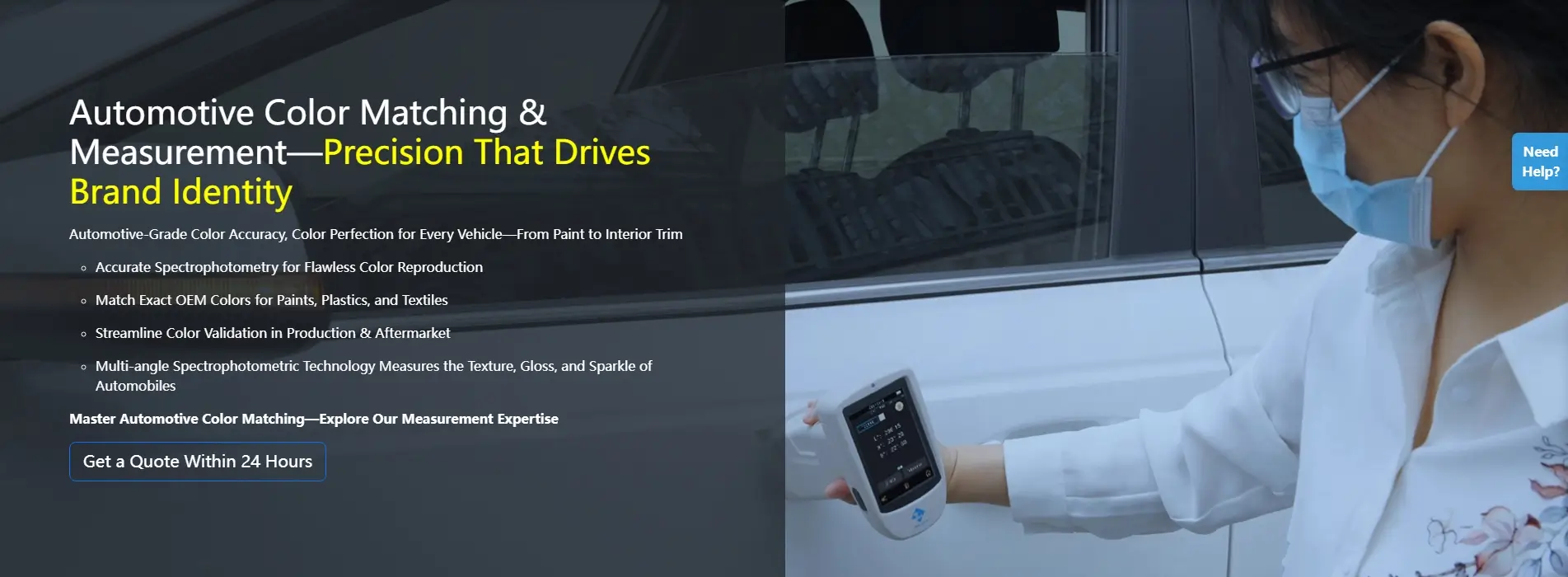Call Now

Various automotive colors can cause extensive reworks, scrap and customer dissatisfaction. Consider purchasing a new car with misaligned panels, which is not an acceptable situation in the quality-conscious market today.
Color consistency in automotive paint colors must be maintained:
· Across different manufacturing facilities
· Through various lighting conditions
· Over time, as production continues
· For different parts of the car (e.g., plastic bumpers vs. metal doors)
This is particularly challenging with automotive metallic paint colors. Since metallic flakes reflect light at varying degrees of angles, which causes perceptual color change.

The above complicated optical effects are not mentioned in conventional single-angle colorimeters or flatbed scanners. Nowadays, due to the clean and polished paint jobs on vehicles, multi-angle spectrophotometers are needed to measure the texture, gloss, and sparkle in paint.
Multi-angle spectrophotometers are the standard in the business of measuring automotive color, particularly metallic and pearlescent finishes. Such devices are important in OEM manufacturing and body shop refinishing as well as quality control processes where precision and repeatability aspects are vital. 3nh MS3012 is a high-quality tool designed for automotive paint matching, uses the recent technology to make precise and reliable color & effect measurements.
A spectrophotometer is a sophisticated optical tool that keeps track of light which has been reflected (or transmitted) by a surface in the visible part of the spectrum (400-700 nm). In automotive applications, it translates these readings into numerical color coordinate readings—commonly CIE Lab*, ΔE, or reflectance curves—that objectively quantify the finish.
Modern spectrophotometers for automotive paint coatings go beyond basic color:
● Capture high-resolution spectral data across multiple viewing angles.
● Store and compare results to digital master standards or tolerances.
● Integrate gloss sensors, sparkle meters, and texture mapping features.
● Interface with color-matching software for formulation, QA, or refinishing.
Multi-angle spectrophotometers provide the reflectance or light absorbance at multiple angles (usually 15°, 25°, 45°, 75°, and 110°) with the outgoing light at a constant angle (usually 45°). Such geometries represent the real-life behavior of light with curved or angled car surfaces.
● Flake Directionality: The aluminum or mica flakes in metallic/pearlescent paints align in the direction of spraying and drying. Multi-angle readings reflect the impact of this orientation on the light scatter and the sparkle at different positions.
● Layer Interactions: A high-end finish such as a tri-coat or candy paints entail a translucent and reflective coating. These cause wavelength dependent interference and change in hue and chroma. These subtle shifts are better detected by Multi-angle instruments as opposed to flat-angle sensors.
● Gloss and Texture Influence: Incorporated gloss meters (usually 20°, 60°, 85°) and sparkle sensors (15° and 45°) enable measurements of brightness, DOI (Distinctness of Image), and surface texture - vital to the evaluation of appearance quality and visual harmony.
Devices like the 3NH MS3008, MS3012 offer precise multi-angle analysis, on-board memory, Bluetooth connectivity, and compatibility with digital color standards (e.g., QTX, CxF files). Thus, helping brands maintain global color consistency.
When selecting a spectrophotometer for color automotive applications, consider these features.
Feature | Why It Matters for Automotive |
Multi-Angle Geometry | Essential for metallic and pearl finishes |
Gloss Measurement | Captures surface reflections affecting perception |
Sparkle and Texture | Measure the flake distribution and visual depth |
Portable or Benchtop | Portability is important for in-line or body shop use |
Data Connectivity | Ability to sync with cloud databases and QC systems |
Ease of Use | Intuitive interface speeds up workflow |